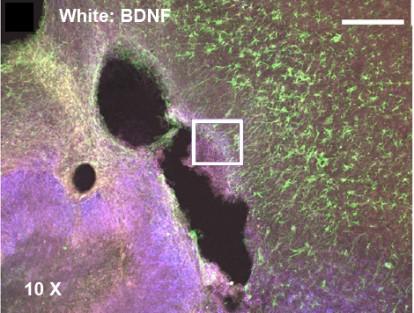
Adrian M. Corbett, Ph.D.
Education History
Ph.D., University of Miami (Florida), 1984
Research Statement
Since 2008, I have worked on the pharmacological increase of adult neurogenesis in middle aged rats (generally post-menopausal in female rats). My basic premise was that many disease states and brain injuries are often worse (show less recovery) when patients are older: if we can make an older brain behave like a younger brain, then functional recovery from any form of brain injury in an older animal should be improved. I have focused on manipulating adult neurogenesis, since increases in neurogenesis are tied to increases in nerve growth factors. Increased nerve growth factors should help an injured nerve survive, reducing injury, and would also help to rewire cortical circuits through increased plasticity in the surviving neurons if some neurons die. We have evaluated this drug treatment as a post-stroke treatment in middle aged rats, showing some amazing functional recovery in grasping after we have targeted the forelimb motor cortex for the ischemic stroke. Interestingly, this treatment, using a combination of Fluoxetine, simvastatin and ascorbic acid, works by a number of different pathways. We believe that the fluoxetine in the injured brain is changing the M1 inflammatory type of microglia into the M2 type, which releases BDNF (see picture). Further evidence to support this comes from two papers (Corbett et al, 2015 and Bach et al, 2015), where we see that ischemic stroke animals treated with our drug combination do not show evidence of extensive infiltrating macrophages and leukocytes and have reduced blood brain barrier permeability, resulting in a smaller infarct volume as well as reducing possible brain edema. Much of the neuronal injury in the infarct is believed to be due to damage caused by M1 type microglia releasing inducible nitric oxide (NOS2) and other inflammatory cytokines, damage that is missing in our treated animals (see 2015 Journal of Neurology and Neuroscience article). We have confirmed in control versus drug combination treated stroked rat brains, using real time PCR custom microarrays with cDNA reversed transcribed from the mRNA in the peri-infarct region, that our drug treatment reliably reduces Nos2, Il1, Tnfa, Fas, Il6, Mmp9 and other proinflammatory cytokines, while increasing Bdnf, Npy, Hpcrt or its receptors (males versus females), Fgf9, Sox2, Camk2g, which supports neuronal survival and plasticity. The simvastatin, we believe, is increasing BDNF through the vascular endothelial nitric oxide synthase. We believe it is also capable of cleaving any microglia released pro-BDNF to BDNF using the plasmin pathway, which results in more beneficial neurotrophins and less antagonizing neurotrophins. The ascorbic acid in our treatment is working to keep the highly oxidizable serotonin and endothial nitric oxide synthase in their non-oxidized forms. These mechanisms have implications for other forms of brain injury, such as Alzheimer’s disease, traumatic brain injury, Parkinson’s disease, as well as chronic neuropathic pain, and I look forward to being able to test the drug combination of animal models of those diseases for an effect.
We have just begun work to determine if the increased neurogenesis in the subventricular zone can be used to remyelinate damaged (demyelinated) white matter tracts in the Corpus Callosum, as a model for injury seen in Multiple Sclerosis. Since we are using older rats, we think this injury might model what is seen in older female human patients, after estrogen loss: could have a correlation to secondary progressive multiple sclerosis.

Figure 1: Microglia (blue; Ox42 antibody) are localized with pro-BDNF (red, Abcam pro-BDNF Ab). GFAP (green) stains the astrocytes in the region and some stem cells in the subventricular zone (upper left corner). BDNF staining is white.
Publications
Sulehria, Tahir; Corbett, Adrian M.; Sharma, Neelima; Nagarajan, Devipriyanka; Abushamma, Amani; Gagle, Samantha; Johnson, Alee. (In press) Increaing Progenitor Cell Proliferation in the Sub-Ventricular Zone: A Therapeutic Treatment for Progressive Multiple Sclerosis?. Rec Patents in Drug Discovery & Formulation (2020)
Ragas, Moner; Nagarajan, Devipriyanka; and Corbett, Adrian.M. 2017. Refining Forelimb Asymmetry Analysis: Correlation with Montoya Staircase Contralateral Function Post-Stroke. Journal of Neuroscience Methods. 290: 52-56.
Balch, M.H.H., Ragas, M.A., Wright, D., Hensley, A., Reynolds, K., Kerr, B., Corbett, A.M. 2015. Appropriate Timing of Fluoxetine and Statin Delivery Reduces the Risk of Secondary Bleeding in Ischemic Stroke Rats. Journal of neurology and Neuroscience, 6, 29-36
Corbett, A.M., Sieber, S., Wyatt, N., Lizzi, J., Flannery, T., Sibbit, B., and Sanghvi, S. 2015. Increasing Neurogenesis with Fluoxetine, Simvastatin, and Ascorbic Acid Leads to Functional Recovery in Ischemic Stroke. Recent Patents on Drug Delivery and Formulation, 9, 158-166
Corbett, A., McGowin, A., Sieber, S., Flannery, T., and Sibbitt, B. 2012. A method for reliable voluntary oral administration of a fixed dosage (mg/kg) of chronic daily medication to rats. Laboratory Animals 46: 324-328
McGowin, A.E., Truong, T.M, Corbett, A.M., Bagley, D.A., Ehrhart, L.M., Bresette, M.J., Weeges, S.T. and Clark, Dave. 2011. Genetic barcoding of marine leeches (Ozobranchus spp.) from Florida sea turtles and their divergence in host specifity. Molecular Ecology Resources. 11(2), 271-278.
Jarnot, M. and A.M. Corbett. 2006. Immunolocalization of NaV1.2 Channel Subtypes in Rat and Cat Brain and Spinal Cord with High Affinity Antibodies. Brain Research 1107: 1-12.
Kramer JW, Ferguson DG, Corbett AM. (2003) Enrichment of triadic and terminal cisternae vesicles from rabbit skeletal muscles. J Membrane Biology 195:9-20.
Castaneda-Castellanos DR, Cano M, Wang JKT, Corbett A, Benson D, Blanck JJ, Thornhill WB, Recio-Pinto E (2000) CNS voltage-dependent Na+ channel expression and distribution in an undifferentiated and differentiated CNS cell line. Brain Res 866:281-285.
Kramer JW, Corbett AM (1996) 1996. Comparison of calcium loading and retention in isolated skeletal muscle triads and terminal cisternae. American J Physiology (Cell Physiology vol. 39) 270:C1602-1610.
Ritucci NA, Corbett AM (1995) The effect of magnesium and ATP on depolarization induced calcium release in isolated skeletal muscle traids. American Journal of Physiology (Cell Physiology vol 38) 269:C85-C95.
Kramer JW, Corbett AM (1995) The voltage dependence of depolarization-induced calcium release in isolated skeletal muscle triads. J Membrane Biol 144:217-230.
Jarnot M, Corbett AM (1995) High titer antibody to mammalian neuronal sodium channels produces sustained channel block. Brain Res 674: 159-162.
Awards/Recognition
Patent: U.S. Patent No 9,254,281. Composition and Method for the Treatment of Neurodegeneration. Patent owned by Wright State University.
PI: Adrian M. Corbett. This application describes a combination of fluoxetine and simvastatin (with or without ascorbic acid) for ischemic stroke or other forms of brain injury, which may be initiated up to 20-26 hours after the brain injury and, with daily treatment, resulting in significant motor function improvement.
